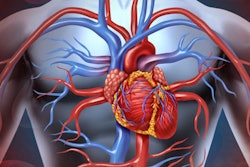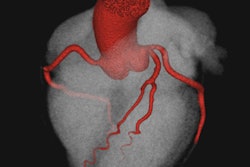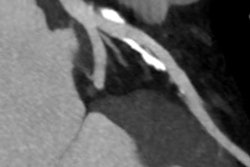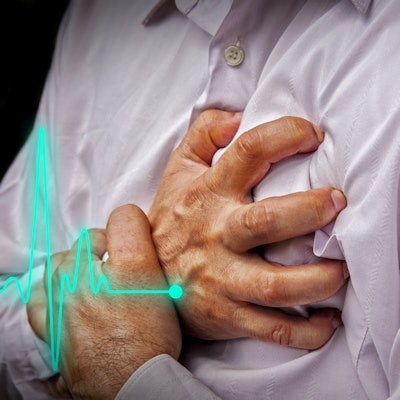
Personalizing patient information and delivering it as a coherent package can bring results in cases of chest pain following a normal CT of the coronary arteries, researchers from Bergen, Norway, reported on 12 December at the European Association of Cardiovascular Imaging congress.
Many patients diagnosed with noncardiac chest pain are reluctant to believe they do not have heart disease, but explaining the test results appropriately can convince patients, boost self-reliance, and reduce episodes of recurring chest pain, according to first author Isabel Krohn, a radiographer at Haukeland University Hospital.
 Isabel Krohn from Bergen, Norway. Photo courtesy of the ESC.
Isabel Krohn from Bergen, Norway. Photo courtesy of the ESC."I explained the information in the brochure and the image, and subtly asked questions to probe if the patient understood. That made it possible to customize the teaching," she noted in a statement issued by the European Society of Cardiology (ESC), which organized the event.
"The sessions took five to 15 minutes depending on how much explanation each patient required. I think discussing the results with patients immediately after the test also helps them to accept the results," she added. "This type of education is likely to become more common in years to come as a way of improving health literacy."
In 2018, around 600 outpatients with chest pain had CT scans at Haukeland University Hospital to examine the coronary arteries, and around a third of patients had no calcium deposits or narrowing of the arterial lumen. Previous research has shown that chest pain has a noncardiac origin in two-thirds of patients. Typical causes are indigestion or acid reflux, musculoskeletal disorders such as back pain or sore muscles between the ribs, and psychological issues like panic attacks and anxiety.
"I noticed that a number of patients who came for a coronary CT to diagnose their chest pain had previously undergone a coronary CT scan and other heart examinations which found no evidence of coronary disease," said Krohn, who completed a master's thesis on this topic in 2019. "Given the excellent prognostic value of coronary CT, I thought this information could be beneficial to this patient group."
Study details
The group evaluated 92 patients with chest pain and normal CT results. The average age was 51 years, and 63 (68%) were women. Patients were randomly allocated to the intervention or control group. The control group received regular care, meaning that around one week after the scans, their general practitioner or other referring doctor told them the result was normal.
The intervention group went through a three-part explanation with the radiographer. In the first part, participants received extended information about the CT examination they just went through -- both orally and in a brochure written in understandable terms. This included the different reasons for chest pain, low probability of inaccurate results, and very low risk of a future heart attack when CT scans show healthy arteries. In the second part, participants were shown their own calcium score images to visually strengthen the message in the brochure. Lastly, the radiographer told patients their results were normal.
Both groups were followed up at one month. Participants were asked to rate on a scale of 0 to 10 the degree to which they believed that the CT scan of their coronary arteries had found no heart disease (0 = no trust in the results; 10 = fully trust the results). Patients in the intervention group were significantly more likely to believe the test results compared with those in the control group.
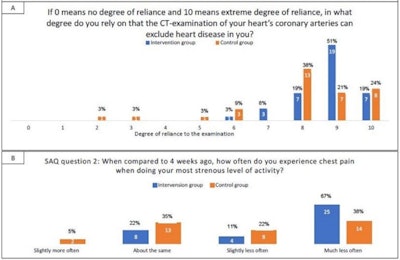 A: Distribution of responses to a specific question on patients' reliance on CT exam. B: Responses of patients who experienced chest pain in the intervention group and control group after follow-up. Percentages within groups and the corresponding number of recipients are shown in each bar. Image courtesy of Isabel Krohn.
A: Distribution of responses to a specific question on patients' reliance on CT exam. B: Responses of patients who experienced chest pain in the intervention group and control group after follow-up. Percentages within groups and the corresponding number of recipients are shown in each bar. Image courtesy of Isabel Krohn.Participants were also asked how often they currently experienced chest pain during their most strenuous level of activity compared with one month ago (slightly more often, about the same, slightly less often, much less often). Two-thirds (67%) of the patients in the intervention group reported experiencing chest pain much less often, compared with 38% of patients in the control group (p = 0.042).
Relatively simple actions can have a great impact on patient care, Krohn pointed out.
"Providing patients with extended information and an early communication of CT results have a positive effect on reliance and chest pain after one month. Such an effect may lead to lower morbidity, less anxiety and a higher quality of life in this group," she stated.
Further examinations after six or 12 months might provide additional knowledge of the long-term effect of the performed intervention, she concluded.





